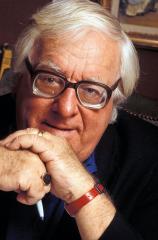Ronald Wimberly on Adapting Ray Bradbury
How do you approach a legendary work like Ray Bradbury’s Something Wicked This Way Comes and turn it into a graphic novel? Very carefully. That’s exactly what creator Ronald Wimberly (author of the critically acclaimed Sentences) did when he took, with Bradbury’s approval, the classic book and turned it into an exciting new graphic adaptation. We discussed the process with him.
How did you come to work on a Ray Bradbury adaptation?
I had just returned from a couple months in European bars and beer gardens, drowning my memories of a woman, to find that New York rent had continued to increase alarmingly, so thankfully, my agent, Bob Mecoy, got me the job.
I hadn't read any of Bradbury's work and I was only familiar with the Truffaut adaptation of Fahrenheit 451. However, a few friends of mine held his work in high regard and an ex girlfriend had left a dog-eared paperback of Something Wicked This Way Comes among my books. I kept it because it had a cool cover and I recognized the title from Macbeth. I had planned to read it, but had no idea what it was about…so I accepted the job. Adventure!
What was the process like? How would you describe working with Ray?
I am still refining my process in general, but for this I developed a stripped-down, more efficient process; one that I could take with me on the road. There wasn't too much in the way of creative freedom, so I had to express myself by carefully choosing what I left in or cut out. I was restricted to using only Bradbury's text, so my first draft used juxtaposition of imagery to "adapt" the story. I created a world that was more like the suburban wasteland I knew as a teenager in the suburbs of the greater Washington, D.C., area. It was subtly disturbing, but I was careful not to change any of Bradbury's writing. Bradbury's people weren't too pleased and basically asked that I make a comic book version of the '80s Disney movie. It was a hard line for me to walk. The result is a book that is more conventional yet is far more creepy and dark to me, because it reflects a mid-20th-century American ideal. An America that excludes and demonizes those that are different.
Since you weren’t too familiar with Bradbury’s work before, would you describe yourself as a fan?
I wouldn't strictly call myself a fan since I was not familiar with Ray Bradbury's work. I had mostly heard of him via friends. I remembered a song that Siouxsie & the Banshees had done inspired by the work. It is the original creepy circus story, I imagine. My original adaptation reflected this, but I had to change it.
How long did you spend working on the book?
I spent about a year working on this off and on. I had a few (mis)adventures along the way.
Was it difficult to fit everything from the book in a graphic novel? Were there parts that had to be excised that you wish you could have kept?
I look at the process of adapting a large text into a graphic work like distillation. You won't fit everything in, but one must try to capture the spirit of the work. The spirit of literature is poetry. Poetry suggests. It's the Impressionism of literature. So I approached it like that. Things are lost, but you can always read Bradbury's original to taste the angel's share.
The audience will never see my original adaptation. It embodied this philosophy, but what I've delivered here hopefully still expresses this way of thinking.
What’s the next project you’re working on?
I'm working on a top-secret project that I will reveal a teaser of here on July 15th. It's called BAAL. I've got a book called Prince of Cats in the can that I am most excited about. It's coming out from Vertigo soon, hopefully. I'll keep you posted.
I hope everyone will enjoy this work, fans and newcomers alike. There is a subtle message for those who read and look carefully.




